The Gentle Giant
In general, earlier periods of society valued dogs for their functionality: guarding, hunting, retrieving other prey, herding, etc. Although family portraits of centuries past often included a dog, and history books mention dogs roaming freely among people, the concept of a dog as “pet” is fairly modern. Like other breeds, and, in particular, the Mastiff breeds, the sweet-natured Bull Mastiff was originally bred for large size. Its function was to guard, and it was trained accordingly.
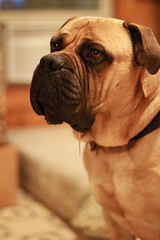
![]() A photoA credit:A LegalAdmin
A photoA credit:A LegalAdmin
Today’s Bull Mastiff arrived on the scene in 19th century England, when the British crossbred the Bulldog and Mastiff to create it. Since then, the magnificent Bull Mastiff has crossed oceans and become popular among many cultures. The U.S. was introduced to the Bull Mastiff in the 1920s, where the dog nonchalantly mingled with the rich and famous. For instance, John D. Rockefeller used a Bull Mastiff as a watchdog on his estate.
A popular 20th century song could be re-named, “Diamonds Are A Dog’s Best Friend,” to describe the breed’s comfort in guarding enormous wealth elsewhere, like the diamond mines of South Africa. It must be quite the surprise for a foolhardy thief to see this security system in motion, especially if the Bull Mastiff is coming his or her way!
The massive, tough Bull Mastiff is not shy about being a celebrity, either. Members of the breed have made a name for themselves as guard dogs in movies like “Rocky.” Lovers of large dogs already know who steals the show when a Bull Mastiff is on the set. Unfortunately, the brave, yet tender-hearted, Bull Mastiff does not give autographs.
Looks and Build
It’s impossible not to see a Bull Mastiff enjoying a stroll down a city street. Adult members of the breed stand 20 to 27 inches tall, and can weigh as much as 130 pounds. In terms of weight, this is the same size as an average adult woman. The Bull Mastiff is sleek, but its well-defined musculature definitely indicates its latent power. A bit broad in the shoulders, the breed looks like it pumps iron in its spare time.
The Bull Mastiff is definitely not a dainty diner. It needs to consume up to three pints of dog food a day. There are undoubtedly many people who wish they could eat so much and still look so good. Certainly, the most important reason for all dog owners to exercise their pet is to maintain its health. However, Bull Mastiff owners may also walk their dogs to stay in shape themselves, so they appear reasonably attractive beside the eye-catching magnificence of their Bull Mastiff.
A striking feature of the Bull Mastiff is its color. Members of the breed have short coats that come in red, faun or brindle. These are the only three official Bull Mastiff colors recognized by the American Kennel Club, but the breed looks fashionable in any of the three.
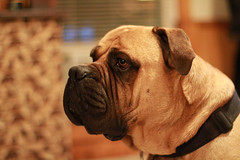
![]()  photo credit: LegalAdmin
 photo credit: LegalAdmin
Individual dogs exhibit coats that are a range of shades within the basic colors. Fawn Bull Mastiffs may be tan, light brown or reddish. The reds come in light, or rich and dark, shades. The brindles have stripes that appear to lie on top of the fawn or red color.
Another striking Bull Mastiff feature is its head. Like the rest of its body, it is broad. The muzzle is shorter than that of other breeds, and black. The face is wrinkled, giving it the distinctive, wizened look of all Mastiff breeds. The Bull Mastiff’s sagging jowls give it a serious, almost sad, look. The eyes can look menacing when the Bull Mastiff is on duty, but have a loving expression when gazing at their human companions.
The ears lie flat and floppy on the sides of the head. Likewise, the tail is left long. This custom of leaving the Bull Mastiff’s ears and tail uncropped distinguishes the breed from one of its similarly large cousins: the German Mastiff, or Great Dane.
Despite the Bull Mastiff’s mass, it is a breed that does not need much space. It is rated as a moderately active dog, unlike, say, the Springer Spaniel. Hence, Bull Mastiffs are known as great “apartment pets.” Like many of their owners, they like to lounge on the couch and watch a little television. It is an amusing pastime to see the Bull Mastiff become alert when it sees or hears another dog on tv, perhaps even cocking its head, sniffing the air to detect a dog scent, or barking back.
As a Pet
Although the Bull Mastiff originated, and maintains its status, as a guard dog, it was actually bred not to bite. Rather, the breed pins down its prey without hurting or killing it. This is fortunate, as its mouth is wide, with large teeth. Whether its opponent is a smaller, uppity dog who thinks it is a mastiff, or a human intruder who wishes he/she was one, the Bull Mastiff is polite but firm.
On the other hand, the Bull Mastiff is remarkably gentle. It can share a bed with a child or another household pet without accidentally sitting on the other. For a large breed, the Bull Mastiff has a good understanding of available space and how to use it. That is not to say a Bull Mastiff does not occasionally and intentionally sit on some of its human companions, just to have a little fun. After all, the human lap is a comfortable place for a Bull Mastiff haunch or head to rest upon.
Health
The Bull Mastiff is a member of its human family, and should be accordingly treated with love and respect. Unlike the other household members, its lifespan is short, averaging eight to ten years, which provides another important reason to cherish this pet while it is around. Like other very large breeds, the Bull Mastiff can suffer a variety of health conditions, such as tumors, arthritis, joint problems and hip dysplasia.
One way to prevent such health issues starts from the get-go, before a person or family gets a Bull Mastiff. Potential owners must be sure to research the health of the breeder’s other litters. They should get references and take the time to call the other dog owners, to see whether their Bull Mastiff puppy was healthy.
If obtaining the dog from a shelter or breed-specific rescue society, potential owners need to get as much of the dog’s physical and emotional history. Although all dogs deserve a wonderful home, do not bring an abused Bull Mastiff into the family unless fully prepared to offer it extra patience and love. It deserves it and will more than repay the kindness.
Grooming and Care
Bull Mastiff owners can feel confident their large bundle of love will love a good grooming. The short coat makes brushing it easy and keeps the fur lustrous-looking. Short-coated dogs also shed, so routine brushing keeps the old fur off the Bull Mastiff, as well as the floor. Keep the toenails trimmed, so the quick does not grow long and make future trimming painful. The occasional tooth brushing would not hurt, either.
As with any routine, start and maintain grooming from the start, so the Bull Mastiff will be accustomed to being touched and enjoy it. Just don’t forget the drool factor. The Bull Mastiff can turn on the saliva, so be sure to keep the drool towel handy. If a Bull Mastiff owner has a little extra money to splurge on her or his beautiful beast, the occasional “spa treatment” at a professional groomer would be a treat.
Training
As with all breeds of dogs, early training is best, and it must be consistent. Bull Mastiffs are bright, but must be reminded their owners mean business every time a command is issued. Additionally, this dog is an independent thinker with a large, powerful body. Train, don’t restrain. The Bull Mastiff and the owner’s arms will be thankful.
Take advantage of the generations of Bull Mastiff breeding which have made this magnificent breed eager to please and amenable to self-discipline. Whether guarding diamonds or its human family, the Bull Mastiff should always experience the good life.


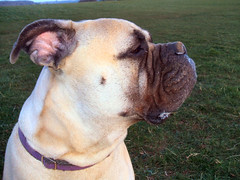

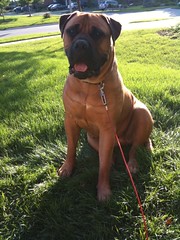

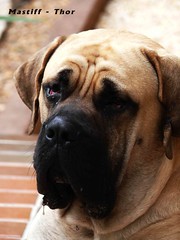

Can anyone explain why my daughters 3year old bitch has started chewing and ripping things up.